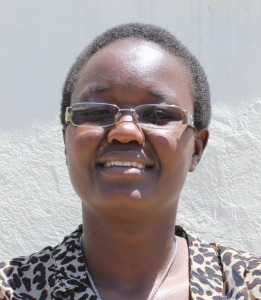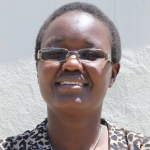June, 2023: Lukhuna Community Spring Protection Complete!
Lukhuna Community now has access to clean water! Thanks to your donation, we transformed Burundu Wangolo Spring into a flowing source of naturally filtered water. We also installed a chlorine dispenser to provide added protection and trained the community on improved sanitation and hygiene practices. Together, these components will unlock the opportunity for community members to live better, healthier lives.
"I do farming, and most of the time, I have had to stay back at home and care for my little children when they [would] fall sick due to the dirty water. That has always dragged my farm work, thus affecting my harvest in the negative. My children's health will improve, and so I believe I'll spend more time at the farm," said farmer Jemimah Wangolo, whom we spoke to when we first visited the community.

Jemimah fetching water.
Children were just as excited as adults about the new water point.
"Play for me with my friends is a very important part of my life in this village. Fetching water previously used to consume a lot of my time, thus making me miss [out] on many games with my friends. The water now flows so well directly in[to] my jerrican saving on my time. I am sure I will enjoy my moments again," said Sylvester O., whom we also spoke to during our initial visit to the community.

Sylvester at the water point.
Preparing for Spring Protection
Community members worked together to source and carry all locally available construction materials to the spring. These included bricks, sand, stones, and fencing poles. Some people also chiseled away at large rocks to break them into gravel. Because people have to carry most items by hand, the material-collection process can take anywhere from a few weeks to months.
When the community was ready, we sent a truck to deliver the remaining construction materials, including cement, plastic tarps, and hardware. Then, our construction artisan and field officers deployed to the spring to begin work. Individual households provided meals throughout each day to sustain the work team.
From Open Source to Protected Spring: A Step-by-Step Process
First, we cleared and excavated the spring area. Next, we dug a drainage channel below the spring and several runoff diversion channels above and around the spring. These help to divert surface contaminants away.

Excavating the site.
To ensure community members could still access water throughout the construction process, we also dug temporary channels around the construction site from the spring's eye. This allowed water to flow without disrupting community members' tasks or the construction work. Excavation created space for setting the spring's foundation, made of thick plastic, wire mesh, concrete, and waterproof cement.

Laying the foundation.
After establishing the base, we started brickwork to build the headwall, wing walls, and stairs. Once the walls had grown tall enough, we began one of the most crucial steps: setting the discharge pipes. The discharge pipes need to be positioned low enough in the headwall so the water level never rises above the spring's eye, yet high enough to allow room for the average jerrycan (a 20-liter container) to sit beneath the pipes without making contact, which prevents cross-contamination.

Building the walls.
If we place the discharge pipes too high above the spring's eye, back pressure could force water to emerge elsewhere. Too low, and community members would not be able to access the water easily. We embedded the pipes using clay (or mortar when the clay is in short supply) and placed them at an incline to ensure water flows in the right direction.

Discharge pipes are set in place.
In coordination with brickwork, we pitched stones on both sides of the spring's drainage channel. We then cemented and plastered each stone, forming the rub walls. These walls discourage people and animals from standing in that area, which could cause soil erosion and a clogged drainage area.
We then cemented and plastered both sides of the headwall and wing walls. These finishing layers reinforce the brickwork and prevent water in the reservoir from seeping through the walls. In turn, enough pressure builds in the reservoir box to push water out through the discharge pipe.
As the headwall and wing walls cured, we cemented and plastered the stairs and installed four tiles beneath the discharge pipe. The tiles protect the concrete from the falling water's erosive force while beautifying the spring and facilitating easy cleaning of the spring floor.

The tiles are set, and the rub walls are completed.
The final stage of construction is backfilling the reservoir box behind the discharge pipe. We cleared the collection box of any debris that may have fallen during construction. Then we redirected the temporary diversion channels back into the reservoir box, channeling water into this area for the first time. We close all other exits to force water through only the discharge pipe.
We filled the reservoir area with the large, clean stones community members had gathered, arranging them in layers like a well-fitting puzzle. We covered the rocks with a thick plastic to minimize potential contamination sources, then piled enough dirt on top to compensate for future settling.

The reservoir box filled with stones.
Community members transplanted grass onto the backfilled soil to help prevent erosion. The collection area was fenced to discourage any person or animal from walking on it. Compaction can lead to disturbances in the backfill layers and potentially compromise water quality.
The construction process took about two weeks of work and patience to allow the cement and plaster to finish curing. As soon as the spring was ready, people got the okay from their local field officers to fetch water.

Clean water flowing!
We officially handed over the spring to mark the community's ownership of the water point. Happiness, thanksgiving, and appreciation were the order of the day, flowing in all directions. The field officer in charge of this project handed it over to the community members through the water user committee members and the land owner. They cheered and celebrated as they listened to the officer who mentioned that the project was now fully in their care.

Community members celebrating their protected spring.
Training on Health, Hygiene, and More
Together with the community, we found their preferred date for training while considering other community calendar events, such as the agricultural season and social events. We requested a representative group of community members to attend training and relay the information learned to the rest of their families and friends.
When the day arrived, facilitators Lillian and Olivia deployed to the site to lead the event. 25 people attended the training, including fourteen women and eleven men. We held the training at the home of the spring's landowner. The cool shade from the trees gave the participants a conducive environment for participants who attended the training.

We covered several topics, including community participation in the project; leadership and governance; personal, dental, and environmental hygiene; water handling and treatment; spring maintenance; the importance of primary health care and disease prevention; family planning; soapmaking; how to make and use handwashing stations; and the ten steps of handwashing.

Community members practice hand washing with trainer Lillian (on the right).
During the leadership and governance session, we held an election for the newly formed water user committee leaders, who will oversee the maintenance of the spring. We also brainstormed income-generating activities. Community members can now start a group savings account for any future minor repairs to the spring and a cooperative lending group, enabling them to develop small businesses.
"The most memorable topic was operation and maintenance. The community members came up with a new position of hygiene patron in the water user committee. They called her "mama safi" in Kiswahili, which literally means hygiene mum. They gave her the authority to discipline anyone who would be found littering around the spring," said field officer Lillian Achieng.
"The second memorable topic was dental care under sanitation and hygiene [topic]. Many participants were amazed to learn that tooth brushing done at night after a meal helps in dental care. Many shared that they would brush their teeth in the morning before having their meals, and the same would happen again the following morning. They learned that brushing after having [a] meal helped leave the mouth clean with no food remains and no attack from bacteria," continued Lillian.

A child from the community practices dental care.
"The training has really given me a sense of responsibility. I have learned that the water point belongs to me and my community, and it's my responsibility to ensure that it is well maintained. I previously never used to bother [with] who messed up the spring by either littering or even demolishing [it], but now I have the knowledge that care begins with me," said 16-year-old Loice S.

Loice enjoying the water.
Conclusion
This project required a substantial collaboration between our staff, our in-country teams, and the community members. When an issue arises concerning the spring, the water user committee is equipped with the necessary skills to rectify the problem and ensure the water point works appropriately and there is guaranteed public access in the future. However, if the issue is beyond their capabilities, they can contact their local field officers to assist them.
Also, we will continue to offer them unmatchable support as a part of our monitoring and maintenance program. We walk with each community, problem-solving together when they face challenges with functionality, seasonality, or water quality. Together, all these components help us strive for enduring access to reliable, clean, and safe water for this community.
With your contribution, one more piece has been added to a large puzzle of water projects. In Kenya, Uganda, and Sierra Leone, we’re working toward complete coverage. That means reliable, maintained water sources within a 30-minute round trip for each community, household, school, and health center. With this in mind, search through our upcoming projects to see which community you can help next!
Thank you for making all of this possible!








 Protected Spring
Protected Spring
 Rehabilitation Project
Rehabilitation Project


































